First Photo of Living, Newly Discovered Myanmar Monkey //More Photos//Updated
Posted by: Loren Coleman on January 10th, 2012

A reconstruction of Rhinopithecus strykeri. Photograph: Thomas Geissmann / Fauna & Flora International
In December 2011, the Guardian posted this note to go with what looked like a living photograph of the newly discovered snub-nosed monkey from Myanmar: “R. strykeri has not yet been photographed in life. The image above is a reconstruction based on photographs of a related species and a specimen of the new one killed by a hunter. ” (In other words, this was a photoshopped attempt to show what the monkey looked like in life.)
The world is greeted this morning with the first living photograph of one of the world’s newest primates, Rhinopithecus strykeri.
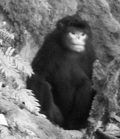
It will be recalled that the October 26, 2010 issue of the American Journal of Primatology announced the discovery of a new primate species, a previously unknown type of snub-nosed monkey, Rhinopithecus strykeri. It was unique in having a nose so upturned that the animals sneeze loudly when it rains. To avoid inhaling water, the monkeys supposedly sit with their heads tucked between their knees on drizzly days, according to local hunters.
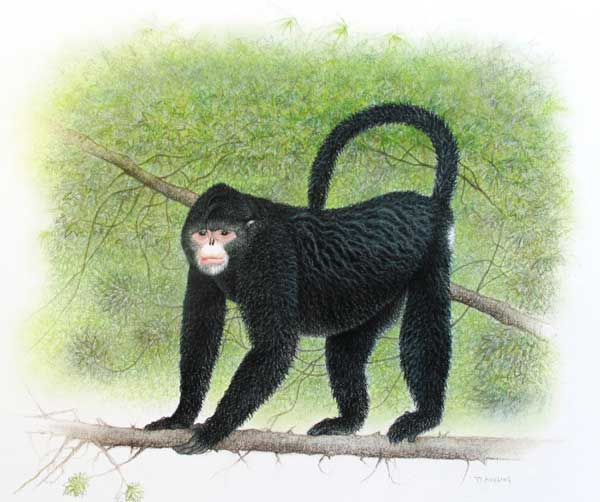
After interviewing locals, scientists discovered the monkey via those killed for food.

The find was made by biologists from the Myanmar Biodiversity and Nature Conservation Association and primatologists from Fauna and Flora International and the People Resources and Biodiversity Foundation.
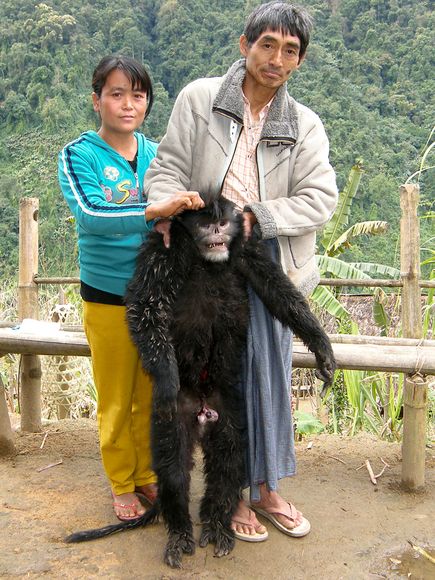
Primatologist Ngwe Lwin took a photograph of the Rhinopithecus strykeri, snub-nosed monkey, in early 2010, that had been harvested for food in Myanmar.
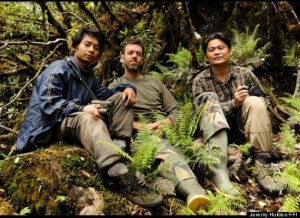

Jeremy Holden (pictured above) of the Flora & Fauna International has shared with me, for release on Cryptomundo, the first photographs of the new primate now known as the Myanmar snub-nosed monkey.
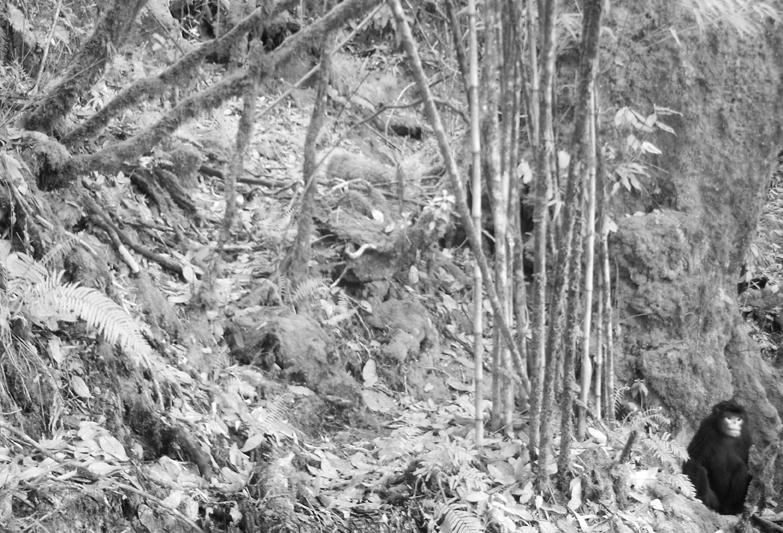


First images of a living Rhinopithecus strykeri. Photocredit: FFI/BANCA


The Flora & Fauna International Release:
Myanmar, 10 january 2012
Researchers working in Northern Myanmar have recently made the first photographs of the recently discovered Myanmar snub-nosed monkey.
A joint team from Fauna & Flora International (FFI), Biodiversity And Nature Conservation Association (BANCA) and People Resources and Conservation Foundation (PRCF), caught the monkey on camera traps placed in the high, forested mountains of Kachin state bordering China.
“The Myanmar snub-nosed monkey was described by science in 2010 from a dead specimen collected from a local hunter,” said Frank Momberg of FFI, who organized the initial expeditions that lead to the monkey’s discovery. “As yet no scientist has seen a live individual”, he added.
“These images are the first record of the animal in its natural habitat,” said Ngwe Lwin, the Burmese national who first recognized the monkey as a possible new species. “It is great to finally have photographs because they show us something about how and where it actually lives.”
[For more on Ngwe Lwin, see here.]
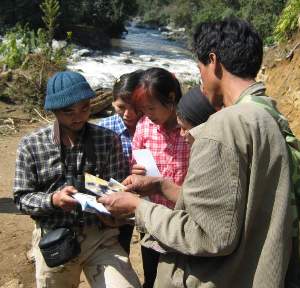
Ngwe Lwin asking local people for information about the little-known species. Photo: FFI/BANCA
Heavy snows in January and constant rain in April, 2011, made expeditions to set the camera traps difficult.
“We were dealing with very tough conditions in a remote and rugged area that contained perhaps fewer than 200 monkeys,” said photographer Jeremy Holden, who lead the camera trapping team. “We didn’t know exactly where they lived, and had to rely on information gathered from hunters; I didn’t hold out much hope of a short term success with this work.”
But in May 2011, a small group of snub-nosed monkeys walked through one of the cameras and into history.
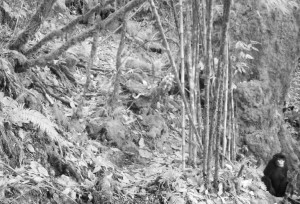
“We were very surprised to get these pictures,” said Saw Soe Aung, a field biologist who set the cameras. “It was exciting to see that some of the females were carrying babies – a new generation of our rarest primate.”
“The images are poor quality compared to what we are now used to seeing from wildlife photographers, but this somehow examplifies the fact that these monkeys are rare, mysterious, and on the brink,” added Holden.
As with most of Asia’s rare mammals, the snub-nosed monkeys are threatened by habitat loss and hunting. The team are now working together with the Ministry for Environmental Conservation and Forest (MOECAF), local authorities and local communities to help safeguard the future of this species. In February 2012, FFI and MOECAF are planning to hold an international workshop in Yangon aiming to create an conservation action plan for the Myanmar Snub-nosed monkey.
The Fauna & Flora International (FFI) protects threatened species and ecosystems worldwide, choosing solutions that are sustainable, based on sound science and take account of human needs. Operating in more than 40 countries worldwide – mainly in the developing world – FFI saves species from extinction and habitats from destruction, while improving the livelihoods of local people. Founded in 1903, FFI is the world’s longest established international conservation body and a registered charity. (The Fauna & Flora International is the group supporting serious research in pursuit of evidence of Orang Pendek in Sumatra.)

Original article on the discovery:
“A new species of snub-nosed monkey, genus Rhinopithecus Milne-Edwards, 1872 (Primates, Colobinae), from northern Kachin state, northeastern Myanmar” by Thomas Geissmann, Ngwe Lwin, Saw Soe Aung, Thet Naing Aung, Zin Myo Aung, Tony Htin Hla, Mark Grindley, Frank Momberg. Article first published online: 27 OCT 2010; American Journal of Primatology.
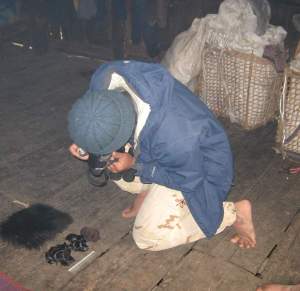
Ngwe Lwin photographing Myanmar snub-nosed monkey body parts on first learning about its existence. Photo: FFI/BANCA
Video footnote:
The following video is found on YouTube and is incorrected labeled as being of this new monkey.
http://www.youtube.com/watch?v=d1VuRvRv_UU
But this is only a relative of Rhinopithecus strykeri that was posted in news articles in 2010, about the new discovery. Since then an Asian site on YouTube has wrongly posted this as being the new Myanmar monkey. They actually appear to be black snub-nosed monkeys found in the Baima Snow Mountain State Nature Reserve in Weixi, southwest China’s Yunnan Province.
About Loren Coleman
Loren Coleman is one of the world’s leading cryptozoologists, some say “the” leading living cryptozoologist. Certainly, he is acknowledged as the current living American researcher and writer who has most popularized cryptozoology in the late 20th and early 21st centuries.
Starting his fieldwork and investigations in 1960, after traveling and trekking extensively in pursuit of cryptozoological mysteries, Coleman began writing to share his experiences in 1969. An honorary member of Ivan T. Sanderson’s Society for the Investigation of the Unexplained in the 1970s, Coleman has been bestowed with similar honorary memberships of the North Idaho College Cryptozoology Club in 1983, and in subsequent years, that of the British Columbia Scientific Cryptozoology Club, CryptoSafari International, and other international organizations. He was also a Life Member and Benefactor of the International Society of Cryptozoology (now-defunct).
Loren Coleman’s daily blog, as a member of the Cryptomundo Team, served as an ongoing avenue of communication for the ever-growing body of cryptozoo news from 2005 through 2013. He returned as an infrequent contributor beginning Halloween week of 2015.
Coleman is the founder in 2003, and current director of the International Cryptozoology Museum in Portland, Maine.










Another case of locals reporting a creature that is later proven. He looks like such a wise old soul.
Burma.
Wow, so clear! Now just for some Sasquatch pictures like this…
Man, that “new pic” really looks Photoshopped to this layman. You know, I wouldn’t trust the Myanmar government to print a newspaper, let alone do field research on a new primate. Take anything that comes out of that country with a grain of salt, people.
PoB:
I’m pretty confident that the superstructure of science trumps totalitarian information control here. The right folks (orgs and individuals) appear to be involved. Moreover, the type of monkey is related to other species that share similar habitat.
I’m not worried, personally.
It has taken we humans 250,000 years to “discover” this http://species.asu.edu/2011_species06 , I think the possibility of there being a Bigfoot still remains.
More photos have been added.
I have to agree with PoB regarding the first pic with the monkey sitting in the bottom right corner, but that may also be due to compression of the file. The others look fine. That top picture (the recreation) just looks wrong, for some reason it reminds me of Micheal Jackson.
But I am glad to see that they are documenting more and more new species and I hope these aren’t as endangered as they appear to be. I’m sure the native hunters could give the researchers a good idea how their numbers have fluctuated over the years, although I doubt the hunters will be happy to hear they will no longer be allowed to hunt this animal for meat.
It is good to see young with them and they appear to be trooping animals so perhaps with patience and dedication a researcher or two might be able to socialize themselves within a troop and learn much more about them, which may well lead to the discovery of even more new animals.
Well, there you go. This one – almost half man size, and traveling in groups! – was pretty much hiding in plain sight. Natives with what appears to be pretty significant contact with Western influences are eating them.
And it’s substantially different from anything related to it, not even sharing range.
This is essentially a Myanmar sasquatch, with one difference:
Science trusted the people who said it was real, and looked.
@flame821
I could not believe that you wrote the photoshop picture looked like “Michael Jackson.” I say that because I was thinking the exact same thing but thought it might not go over to well if I posted it!
I also agree that this type of discover bodes well for the same think happening with the sasquatch/Bigfoot/Yeti.
DWA, I like your observation that this is basically a Myanmar Sasquatch. Asute, thanks.
@ William
Most people on this site tend not to be knee-jerk reactionaries and would take my comment to mean exactly what I said. It looks like many of the more recent photos of the celebrity Micheal Jackson. I think its the recessed eyes and nose area mostly.
And it is really cute. I can easily see this species being made into plushies for fund raisers. I’m honestly surprised the villagers eat them instead of raising them as pets but different cultures have different values, and let’s face it, filling your children’s bellies is pretty high up on the lists of must do.
DWA is quite right. If something this well known and of this size went for so long without being documented by Zoologists (mind it is large, social (trooping) and lives close to humans) it is not too much of a leap to say an extremely large, solitary, and possibly territorial/aggressive primate can live within a stone’s throw of civilization.
Hilarious! “photoshop picture looked like “Michael Jackson”…I thought the same thing when I saw the first picture of the face. Not being rude but it did look a bit like Michael…giggle.